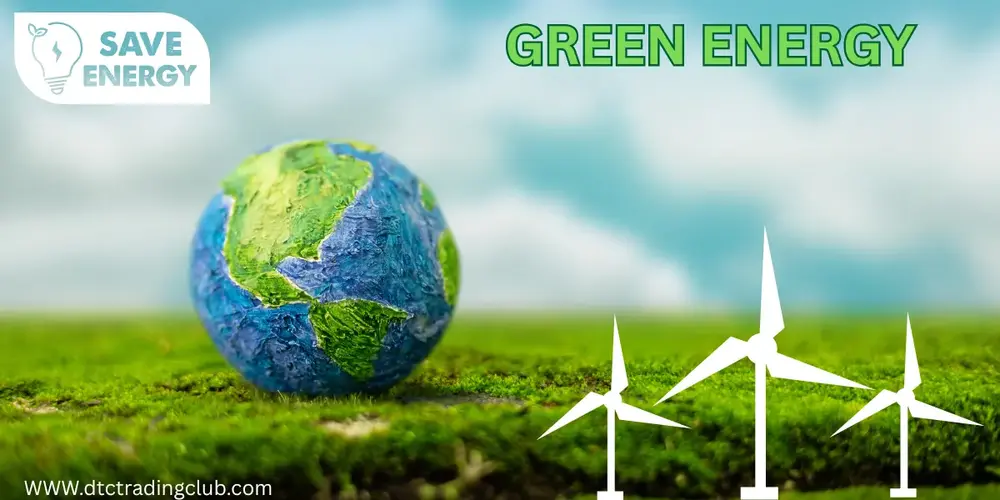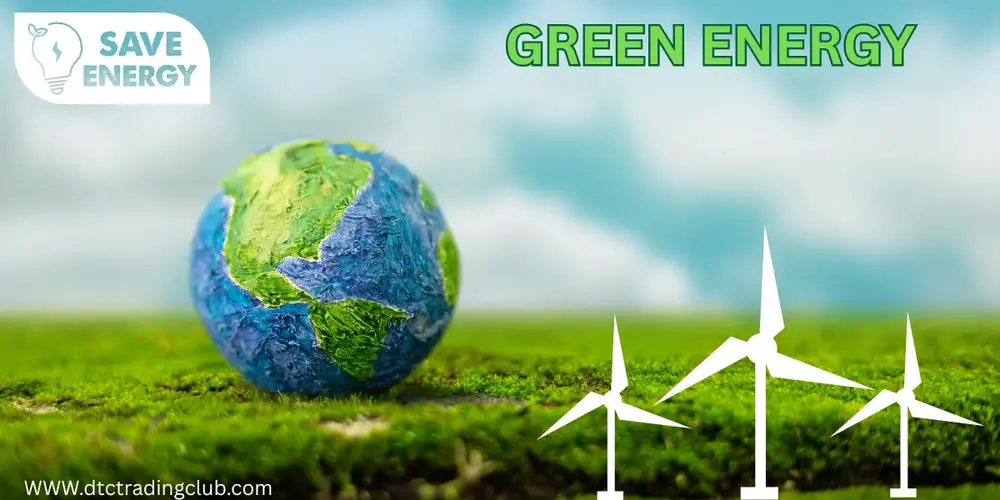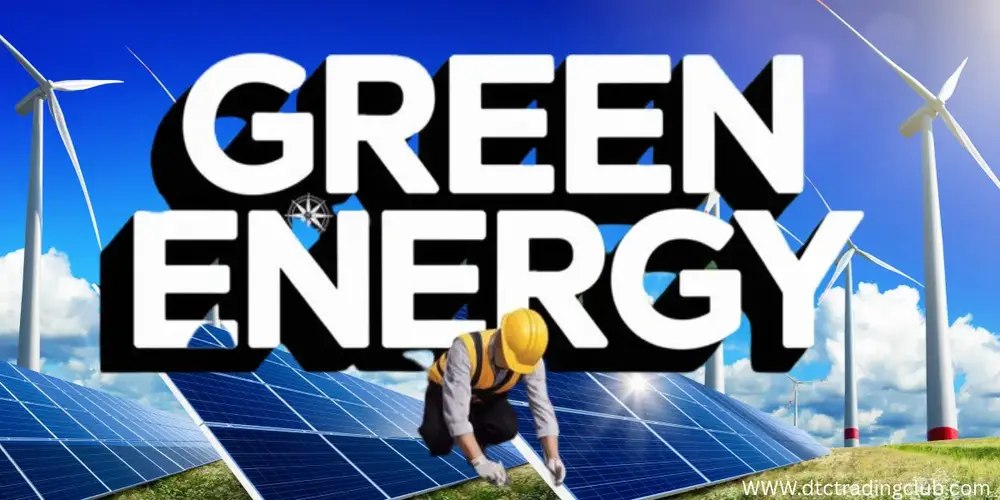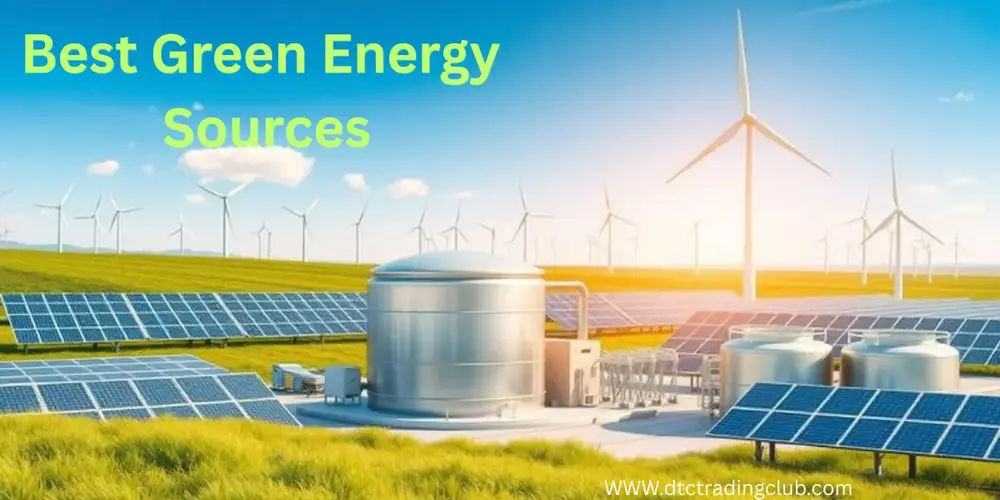Introduction:
Energy powers our lives: from lighting our homes to charging our phones. But many traditional sources like coal, oil, and gas harm the planet through pollution and greenhouse gas emissions. That’s why choosing the best green energy sources matters more than ever.
In this blog, we’ll first answer “What is renewable energy?” and then give you 5 examples of different renewable energies before diving deeper into 7 top green energy sources shaping a sustainable future. We’ll also explore the advantages of renewable energy, all conveyed in a warm, relatable, human tone.

Table of Contents
What Is Renewable Energy?
Renewable energy refers to energy derived from natural sources that are continuously replenished—sunlight, wind, flowing water, Earth’s heat, and organic matter. Unlike fossil fuels, renewables don’t run out and typically release little or no greenhouse gases during operation
In simple terms: it’s clean, reliable energy that nature keeps refilling—sunlight every day, wind every morning, rivers flowing without fuel. It powers progress without depleting resources or hurting the environment.
List 5 Examples of Different Renewable Energies.

Here are five well-known renewable energy types:
- Solar energy (from sunlight)
- Wind energy
- Hydropower (from moving water)
- Biomass energy (from organic materials)
- Geothermal energy (from the Earth’s heat)
You can also include emerging marine sources like wave or tidal energy, or green hydrogen made through renewable-powered electrolysis.
Why These Count Among the Best Green Energy Sources
Not all green energy sources are equal—these seven deserve the spotlight:
1. Solar Power
What it is: Solar energy captures the sun’s rays and converts them into electricity or heat. It’s one of the most popular and widely used renewable energy sources.
How it works: Using solar panels or photovoltaic (PV) cells, sunlight is converted into electricity. Solar thermal systems can also heat water or air.
Advantages:
- Abundant and available everywhere
- Reduces electricity bills
- Low maintenance costs
- Zero emissions during use
Real-world use: Countries like India, China, and the U.S. are investing heavily in solar farms and rooftop solar installations.
2. Wind Power
What it is: Wind energy uses the power of the wind to generate electricity through turbines.
How it works: As the wind blows, it pushes the large blades of a turbine, causing them to rotate. This spinning motion drives a generator, which then creates electricity cleanly and efficiently. It can be used both onshore and offshore.
Advantages:
- Clean and efficient
- Low operating costs
- Scalable for small or large applications
Real-world use: Denmark generates over 40% of its electricity from wind. The U.S. and Germany also lead in wind power installations.
3. Hydropower
What it is: Hydropower harnesses the energy from flowing or falling water to generate electricity.
How it works: Water released from a reservoir or flowing in a river turns turbines that generate electricity.
Advantages:
- Reliable and consistent energy source
- Excellent for grid stability
- Helps with water management and irrigation
Real-world use: The Three Gorges Dam in China is the largest hydroelectric power plant in the world.
4. Geothermal Energy
What it is: Geothermal energy taps into the natural heat stored beneath the Earth’s surface—like that found in hot springs or underground steam reservoirs—to generate clean power.
How it works: Wells are drilled into the Earth to access steam or hot water, which spins turbines to generate electricity.
Advantages:
- Constant energy output (24/7)
- Low emissions
- Small land footprint
Real-world use: Iceland generates over 25% of its electricity from geothermal sources.
5. Biomass Energy
What it is: Biomass energy is produced from organic materials such as wood, crop waste, and animal manure.
How it works: Biomass can be burned directly for heat or converted into biofuels like ethanol and biodiesel.
Advantages:
- Converts waste into energy
- Can reduce dependence on fossil fuels
- Supports rural economies
Real-world use: Brazil is a leading user of biomass, especially ethanol from sugarcane.
6. Tidal Energy
What it is: Tidal energy captures energy from the rise and fall of ocean tides.
How it works: Turbines placed in tidal streams or barrages generate electricity as water moves in and out.
Advantages:
- Predictable and reliable
- Minimal carbon footprint
- Long lifespan of equipment
Real-world use: France and South Korea have developed large-scale tidal power stations.
7. Hydrogen Fuel Cells
What it is: Hydrogen fuel cells generate electricity by combining hydrogen gas with oxygen—and the only thing they emit is water vapor. It’s a clean and efficient way to power everything from cars to homes.
How it works: Hydrogen reacts with oxygen in a fuel cell to generate electricity.
Advantages:
- Clean alternative for transportation
- Can be used where batteries fall short
- High energy density
Real-world use: Companies like Toyota and Hyundai are producing hydrogen-powered vehicles.
Advantages Renewable And Energy

1. Environmentally Friendly
- Significantly reduces carbon emissions
- Helps combat global warming and air pollution
2. Sustainable and Abundant
- Natural sources like the sun, wind, and flowing water are endlessly available and constantly renewing themselves, making them perfect for long-term energy needs.
3. Energy Independence
- Reduces reliance on imported fossil fuels
4. Job Creation
- Green energy industries create millions of jobs globally
5. Economic Benefits
- Reduces long-term energy costs
- Investment in green technology boosts innovation
6. Improved Public Health
- Less pollution leads to better respiratory and cardiovascular health
7. Technological Innovation
- Drives progress in battery storage, smart grids, and EVs
Challenges to Consider
While green energy is promising, there are challenges:
- Initial Cost: Solar panels or wind turbines have high upfront costs.
- Storage Issues: Energy storage technology (like batteries) is still evolving.
However, innovation and investment are helping overcome these barriers.
READ MORE
FAQs:
1. What is renewable energy, and how does it work?
ANSWER: Renewable energy is energy from natural resources like sunlight, wind, and water that are constantly replenished. Technologies like solar panels and wind turbines convert these sources into usable electricity.
2. What are the best green energy sources available today?
ANSWER: The best green energy sources include solar, wind, hydropower, geothermal, biomass, tidal energy, and hydrogen fuel cells—each offering a clean alternative to fossil fuels.
3. Can you list 5 examples of different renewable energies?
ANSWER: Yes! Common examples are solar energy, wind energy, hydropower, geothermal energy, and biomass energy. All are sustainable and eco-friendly.
4. Which renewable energy will be the most efficient in 2025?
ANSWER: Solar and wind energy continue to lead in efficiency, with new advancements in battery storage and smart grid technology boosting their reliability.
5. Is green energy expensive to install at home?
ANSWER: The initial cost of installing solar panels or wind turbines can be high, but long-term savings and government subsidies make it more affordable than ever.
6. What are the disadvantages of renewable energy?
ANSWER: While renewable energy is clean and sustainable, it can be weather-dependent, expensive upfront, and sometimes limited by storage technology.
Conclusion: The Future Is Green
Renewable energy solutions are the key to a cleaner, more resilient world. By investing in the best green energy sources, we not only protect our environment but also create a more sustainable economy and lifestyle.
From solar rooftops to hydrogen vehicles, the green revolution is already underway. As individuals, businesses, and governments come together, the future of energy looks brighter—and greener—than ever before.
